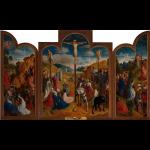This archived website 'Flemish primitives' is temporarily not being updated. Certain functionality (e.g. specific searches in the collection) may no longer be available. News updates about the Flemish primitives will appear on vlaamsekunstcollectie.be. Questions about this website? Please contact us at info@vlaamsekunstcollectie.be.
Joos van Wassenhove
Giorgio Vasari (1511-1574) mentions in his Le vite that the painting, Communion of the Apostles, which is found in Urbino, was painted by ‘Giusto da Guanto', or Joos van Ghent. This painter departed from Flanders around 1470 for Italy and went into the service of Federico da Montefeltro, Duke of Urbino. The artist that Vasari means is probably the painter Joos van Wassenhove, who in 1460 becomes a member of the Antwerp Guild of St. Luke and in 1464 a freemaster in the Ghent painters' guild. In Ghent, he vouched for Hugo van der Goes, Sanders Bening and Agnes van den Bossche for their entrance into the painters' guild.
The monumental Crucifixion Altarpiece (Saint Bavo Cathedral, Ghent) is the only preserved panel painting of Joos van Wassenhove that existed before his departure for Italy. The canvas painting (or Tüchlein), Devotion of the Kings (Metropolitan Museum of Art, New York), whose provenance is the convent of Santa Clara in Burgos and was possibly an assignment of the prestigious Fernández de Velasco family, is characterised by a similar monumental style of figures. The figures, whose facial features and colour spectrum, are closely related to the oeuvre of Hugo van der Goes. The two masters probably worked together, before van Wassenhove departed for Rome around 1470. In addition, one ought to note a relationship with the work of Dieric Bouts.
In Italy, Joos van Wassenhove worked as one of the court painters of Federico da Montefeltro, one of the most important art connoisseurs of the Italian Renaissance. On commission by the prince, he painted the Communion of the Apostles between 1472 and 1474 for the brotherhood of the Corpus Christi in Urbino. He was involved with the decoration of the ducal residences in Urbino and Gubbio. This dealt with the portrait series of the Uomini famosi, or famous men (Musée du Louvre, Paris and Galleria Nazionale, Urbino) that he painted in collaboration with the Castilian painter, Pedro Berruguette, for the studio of Federico da Montefeltro.
1460
Joos van Wassenhove becomes freemaster in the Guild of St. Luke in Antwerp.
1464
Van Wassenhove moves to Ghent and becomes a member of the painters' guild on 6 October. The merchant Daniel Rutaert and the goldsmith Jan de Voss vouch for the painter.
1467
Van Wassenhove vouches for Hugo van der Goes for his entrance as freemaster into the Ghent painters' guild.
1469
Along with Hugo van der Goes, Joos van Wassenhove vouches for Sanders Bening, and along with Lievin van den Bossche, van Wassenhove vouches for Agnes van den Bossche.
1467-68
Van Wassenhove is paid for the production of 40 coats of arms of the Pope.
1470
Joos van Wassenhove travels to Rome.
1472
The painter enters into the service of Federico da Montefeltro in Urbino.
1473
First mention of ‘Giusto da Gand' in the Urbino archives.
1472-74
Joos van Wassenhove paints the Communion of the Apostles.
Circa 1480
Van Wassenhove dies.
Till-Holger Borchert








